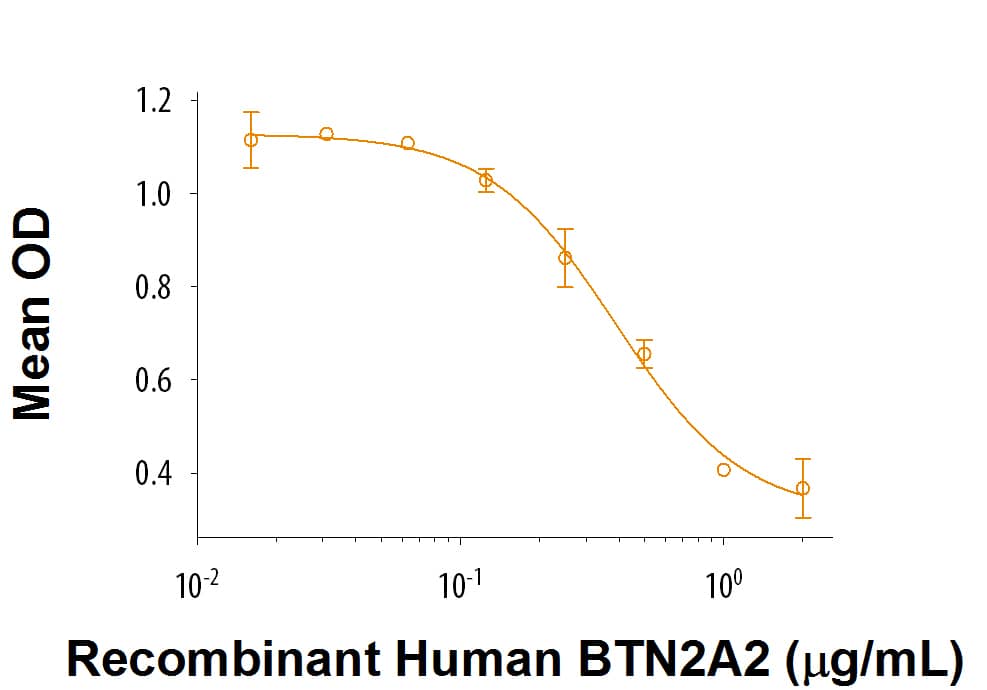Recombinant Human BTN2A2/Butyrophilin 2A2 Fc Protein, CF
R&D Systems, part of Bio-Techne | Catalog # 8918-BT

Key Product Details
Source
HEK293
Accession #
Structure / Form
Disulfide-linked homodimer
Conjugate
Unconjugated
Applications
Bioactivity
Product Specifications
Source
Human embryonic kidney cell, HEK293-derived human BTN2A2/Butyrophilin 2A2 protein
| Human BTN2A2 (Gln33-Val237) Accession # Q8WVV5 |
IEGRMD | Human IgG1 (Pro100-Lys330) |
| N-terminus | C-terminus |
Purity
>95%, by SDS-PAGE visualized with Silver Staining and quantitative densitometry by Coomassie® Blue Staining.
Endotoxin Level
<0.10 EU per 1 μg of the protein by the LAL method.
N-terminal Sequence Analysis
No result obtained. Gln33 inferred from enzymatic pyroglutamate treatment revealing Phe34
Predicted Molecular Mass
50 kDa
Activity
Measured by its ability to inhibit anti-CD3 antibody induced IL-2 secretion in human T lymphocytes.
The ED50 for this effect is 0.1-0.5 μg/mL.
The ED50 for this effect is 0.1-0.5 μg/mL.
Scientific Data Images for Recombinant Human BTN2A2/Butyrophilin 2A2 Fc Protein, CF
Recombinant Human BTN2A2/Butyrophilin 2A2 Fc Protein Bioactivity
Recombinant Human BTN2A2/Butyrophilin 2A2 Fc Chimera (Catalog # 8918-BT) inhibits anti-CD3 antibody-induced IL-2 secretion in human T lymphocytes. The ED50 for this effect is 0.1-0.5 μg/mL.Formulation, Preparation and Storage
8918-BT
| Formulation | Lyophilized from a 0.2 μm filtered solution in PBS. |
| Reconstitution |
Reconstitute at 100 μg/mL in PBS.
|
| Shipping | The product is shipped at ambient temperature. Upon receipt, store it immediately at the temperature recommended below. |
| Stability & Storage | Use a manual defrost freezer and avoid repeated freeze-thaw cycles.
|
Background: BTN2A2/Butyrophilin 2A2
References
- Arnett, H.A. and J.L. Viney (2014) Nat. Rev. Immunol. 14:559.
- Smith, I.A. et al. (2010) J. Immunol. 184:3514.
- Ammann, J.U. et al. (2013) J. Immunol. 190:5030.
- Sinkus, M.L. et al. (2013) Brain Behav. Immun. 32:51.
Long Name
Butyrophilin Subfamily 2 Member A2
Alternate Names
BTF2, BTN2, Butyrophilin 2
Gene Symbol
BTN2A2
UniProt
Additional BTN2A2/Butyrophilin 2A2 Products
Product Documents for Recombinant Human BTN2A2/Butyrophilin 2A2 Fc Protein, CF
Product Specific Notices for Recombinant Human BTN2A2/Butyrophilin 2A2 Fc Protein, CF
For research use only
